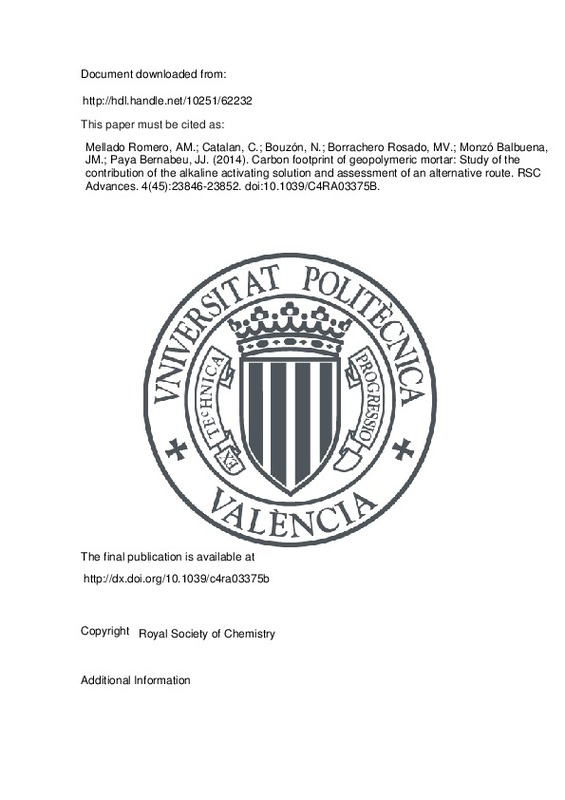Phair, J. W. (2006). Green chemistry for sustainable cement production and use. Green Chemistry, 8(9), 763. doi:10.1039/b603997a
Parvulescu, A., Rossi, M., Pina, C. D., Ciriminna, R., & Pagliaro, M. (2011). Investigation of glycerol polymerization in the clinker grinding process. Green Chem., 13(1), 143-148. doi:10.1039/c0gc00107d
Mymrin, V., de Araújo Ponte, H., Ferreira Lopes, O., & Vazquez Vaamonde, A. (2003). Environment-friendly method of high alkaline bauxite’s Red Mud and Ferrous Slag utilization as an example of green chemistry. Green Chem., 5(3), 357-360. doi:10.1039/b300495n
[+]
Phair, J. W. (2006). Green chemistry for sustainable cement production and use. Green Chemistry, 8(9), 763. doi:10.1039/b603997a
Parvulescu, A., Rossi, M., Pina, C. D., Ciriminna, R., & Pagliaro, M. (2011). Investigation of glycerol polymerization in the clinker grinding process. Green Chem., 13(1), 143-148. doi:10.1039/c0gc00107d
Mymrin, V., de Araújo Ponte, H., Ferreira Lopes, O., & Vazquez Vaamonde, A. (2003). Environment-friendly method of high alkaline bauxite’s Red Mud and Ferrous Slag utilization as an example of green chemistry. Green Chem., 5(3), 357-360. doi:10.1039/b300495n
Fernández Bertos, M., Li, X., Simons, S. J. R., Hills, C. D., & Carey, P. J. (2004). Investigation of accelerated carbonation for the stabilisation of MSW incinerator ashes and the sequestration of CO2. Green Chem., 6(8), 428-436. doi:10.1039/b401872a
J. L. Provis and J. S. J.van Deventer, Geopolymers. Structure, processing, properties and industrial applications, Woodhead Publishing Limited and CRC Press LLC, UK, 2009
F. Pacheco-Torgal and S.Jalali, Eco-efficient Construction and Building Materials, Springer, London, 2011
Pacheco-Torgal, F., Castro-Gomes, J., & Jalali, S. (2008). Alkali-activated binders: A review. Construction and Building Materials, 22(7), 1305-1314. doi:10.1016/j.conbuildmat.2007.10.015
Pacheco-Torgal, F., Castro-Gomes, J., & Jalali, S. (2008). Alkali-activated binders: A review. Part 2. About materials and binders manufacture. Construction and Building Materials, 22(7), 1315-1322. doi:10.1016/j.conbuildmat.2007.03.019
Komnitsas, K., & Zaharaki, D. (2007). Geopolymerisation: A review and prospects for the minerals industry. Minerals Engineering, 20(14), 1261-1277. doi:10.1016/j.mineng.2007.07.011
Duxson, P., Fernández-Jiménez, A., Provis, J. L., Lukey, G. C., Palomo, A., & van Deventer, J. S. J. (2006). Geopolymer technology: the current state of the art. Journal of Materials Science, 42(9), 2917-2933. doi:10.1007/s10853-006-0637-z
Tashima, M. M., Akasaki, J. L., Castaldelli, V. N., Soriano, L., Monzó, J., Payá, J., & Borrachero, M. V. (2012). New geopolymeric binder based on fluid catalytic cracking catalyst residue (FCC). Materials Letters, 80, 50-52. doi:10.1016/j.matlet.2012.04.051
Rodríguez, E. D., Bernal, S. A., Provis, J. L., Gehman, J. D., Monzó, J. M., Payá, J., & Borrachero, M. V. (2013). Geopolymers based on spent catalyst residue from a fluid catalytic cracking (FCC) process. Fuel, 109, 493-502. doi:10.1016/j.fuel.2013.02.053
Tashima, M. M., Soriano, L., Monzó, J., Borrachero, M. V., & Payá, J. (2013). Novel geopolymeric material cured at room temperature. Advances in Applied Ceramics, 112(4), 179-183. doi:10.1179/1743676112y.0000000056
Tashima, M. M., Akasaki, J. L., Melges, J. L. P., Soriano, L., Monzó, J., Payá, J., & Borrachero, M. V. (2013). Alkali activated materials based on fluid catalytic cracking catalyst residue (FCC): Influence of SiO2/Na2O and H2O/FCC ratio on mechanical strength and microstructure. Fuel, 108, 833-839. doi:10.1016/j.fuel.2013.02.052
Duxson, P., Provis, J. L., Lukey, G. C., & van Deventer, J. S. J. (2007). The role of inorganic polymer technology in the development of ‘green concrete’. Cement and Concrete Research, 37(12), 1590-1597. doi:10.1016/j.cemconres.2007.08.018
Habert, G., d’ Espinose de Lacaillerie, J. B., & Roussel, N. (2011). An environmental evaluation of geopolymer based concrete production: reviewing current research trends. Journal of Cleaner Production, 19(11), 1229-1238. doi:10.1016/j.jclepro.2011.03.012
Turner, L. K., & Collins, F. G. (2013). Carbon dioxide equivalent (CO2-e) emissions: A comparison between geopolymer and OPC cement concrete. Construction and Building Materials, 43, 125-130. doi:10.1016/j.conbuildmat.2013.01.023
M. Weil , K.Dombroswski and A.Buchwald, in Geopolymers. Structure, processing, properties and industrial applications, ed. J. L. Provis and J. S. J. van Deventer, Woodhead Publishing Limited and CRC Press LLC, UK, 2009, pp. 194–210
Salas, A., Delvasto, S., de Gutierrez, R. M., & Lange, D. (2009). Comparison of two processes for treating rice husk ash for use in high performance concrete. Cement and Concrete Research, 39(9), 773-778. doi:10.1016/j.cemconres.2009.05.006
Payá, J., Monzó, J., Borrachero, M. ., Mellado, A., & Ordoñez, L. . (2001). Determination of amorphous silica in rice husk ash by a rapid analytical method. Cement and Concrete Research, 31(2), 227-231. doi:10.1016/s0008-8846(00)00466-x
J. Bejarano , C.Garzón, R.Mejía de Gutiérrez, S.Delvasto and M.Gordillo, in II Simposio Aprovechamiento de residuos agro-industriales como fuente sostenible de materiales de construcción, Valencia, Spain, 2010, pp. 409–418
Bouzón, N., Payá, J., Borrachero, M. V., Soriano, L., Tashima, M. M., & Monzó, J. (2014). Refluxed rice husk ash/NaOH suspension for preparing alkali activated binders. Materials Letters, 115, 72-74. doi:10.1016/j.matlet.2013.10.001
IPCC , Revised 1996 IPCC Guidelines for National Greenhouse Gas Inventories, Greenhouse Gas Inventory Reference Manual, Workbook, 1997, vol. 2
V. Årskog , S.Fossdal and O. E.Gjørv, in Proceedings of the International Workshop on Sustainable Development and Concrete Technology, Beijing, China, 2004, pp. 193–200
Peris Mora, E. (2007). Life cycle, sustainability and the transcendent quality of building materials. Building and Environment, 42(3), 1329-1334. doi:10.1016/j.buildenv.2005.11.004
Damineli, B. L., Kemeid, F. M., Aguiar, P. S., & John, V. M. (2010). Measuring the eco-efficiency of cement use. Cement and Concrete Composites, 32(8), 555-562. doi:10.1016/j.cemconcomp.2010.07.009
J. Davidovits , in Geopolymer, Green Chemistry and Sustainable Development Solutions World Congress Proc., 2005, pp. 9–15
McLellan, B. C., Williams, R. P., Lay, J., van Riessen, A., & Corder, G. D. (2011). Costs and carbon emissions for geopolymer pastes in comparison to ordinary portland cement. Journal of Cleaner Production, 19(9-10), 1080-1090. doi:10.1016/j.jclepro.2011.02.010
IDAE Instituto para la Diversificación y Ahorro de la Energía, http://www.idae.es/index.php, Ministerio de Industria, Energía y Turismo, Secretaría de Estado de Energía, Madrid, España
PAS 2050 , Specification for the assessment of the life cycle greenhouse gas emissions of goods and services, British Standards Institution, UK, 2011
Yang, K.-H., Song, J.-K., & Song, K.-I. (2013). Assessment of CO2 reduction of alkali-activated concrete. Journal of Cleaner Production, 39, 265-272. doi:10.1016/j.jclepro.2012.08.001
[-]







![[Cerrado]](/themes/UPV/images/candado.png)


